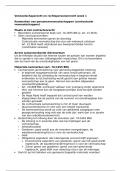Samenvatting
Chapter 3 The Fundamentals of Economic Growth summary (FEB11002 Macro-economie)
Heldere Engelse samenvatting van hoofdstuk 3 van het boek Burda & Wyplosz. Handig per paragraaf ingedeeld en belangrijke begrippen zijn vet gedrukt. Onderdeel van het tentamen van onder andere het eerste jaar van Economie en Bedrijfseconomie, Fiscale Economie en Mr.drs.-programma. FEB11002 Macro-ec...
[Meer zien]














